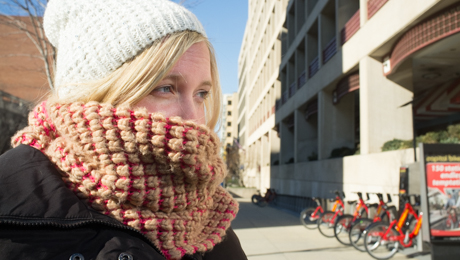As the coldest air in nearly two decades sweeps from the Midwest to the East Coast, cities across the country are experiencing below-freezing, record-breaking temperatures—and Washington, D.C., is not immune to the “polar vortex.”
On Tuesday, temperatures in the District plummeted into the single digits, and wind chills ranged from negative 10 to negative 15.
Extreme weather is more than a nuisance for Washingtonians, it could be downright dangerous, said Leana Wen, director of patient-centered care research at the George Washington University Hospital and an instructor of emergency medicine in the School of Medicine and Health Sciences.
When exposed to the cold, your body preserves energy in its core by slowing down blood supply to the extremities, Dr. Wen said. This puts unexposed ears, fingers and toes at risk for frostbite.
“When it’s very cold, frostbite can set in within minutes,” she said.
And your mother wasn’t lying—dressing appropriately can help keep you safe.
It's important to keep your extremities covered and dry whenever you walk outside, said David Borenstein, a rheumatologist and clinical professor of medicine in SMHS. He recommends wearing mittens instead of gloves, because they allow fingers to warm one another. There is debate as to how much heat a person actually loses from the head, said Dr. Borenstein. But a hat or ear muffs will protect the ears, which are susceptible to frostbite. Wear thick socks, and if they get wet, remove them immediately, he said.
What are the first signs of frostbite? Your hands or feet will experience tingling or burning, and then your skin will begin to look pale, Dr. Wen explained. This is your body warning you to head inside. Run lukewarm (not hot) water over the affected area, until you get sensation back.
If you’re exposed to cold temperatures for an extended period of time, frostbite can become hypothermia as the body’s core temperature drops. Symptoms of hypothermia are confusion, light headedness and fatigue, Dr. Wen said. Young children and the elderly are most at risk and should limit their time outdoors to 15 minutes.
Wearing multiple, loose layers will conserve body heat. Dr. Wen said people shouldn’t abandon their exercise routines in the winter, but it is important to wear clothes that will trap body heat and wick away moisture. Improper clothing clings to sweat and can freeze when wet.
If you think alcohol could help warm you up, think again. Alcohol and freezing temperatures are a dangerous mix, according to Dr. Wen, because the body is tricked into thinking it's warm.
“If you are drunk, you may not feel cold, while actually, your body’s temperature is dropping quickly,” she said.
Still, young, healthy bodies can adapt “surprisingly well” to the cold, Dr. Borenstein said. However, for those with pre-existing health conditions, such as arthritis, the winter can be particularly painful.
While there is no definitive evidence as to whether the weather is really to blame, many of Dr. Borenstein’s patients say their joint pain worsens in frigid temperatures.
What could be the cause? A drop in barometric pressure—which often accompanies cold, stormy weather—allows tissues to expand, as air pressure pushes less against the body, he said. This, in turn, causes fluid to shift around the body. If someone has joint damage, the fluids move less freely, and the drop in air pressure can lead to stiffness and pain.
“These patients have barometers on them. It doesn’t happen all the time, but there may be those telltale joints that are very sensitive,” Dr. Borenstein said. “And if there is enough of a change, quickly enough, they may notice it.”
Patients with arthritis, lupus and scleroderma are more likely to experience Raynaud's phenomenon, which can significantly worsen during the winter months, Dr. Borenstein said.
If a person has Raynaud's, his or her body’s response to the cold is exaggerated. During a Raynaud’s attack, hands and feet will turn from white to blue to red. The condition is mostly just frustrating for those affected, but in extreme temperatures, Raynaud’s can become serious—leading to tissue damage and skin ulcers, Dr. Borenstein explained.
Temperatures in Washington are predicted to rise this weekend but could remain subfreezing until midday Thursday. The bottom line? Bundle up.


